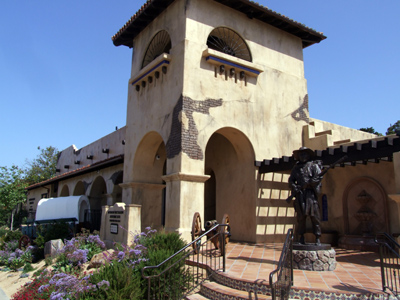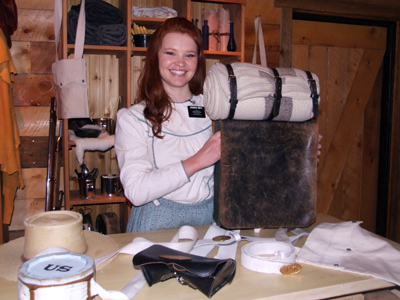
By Donald H. Harrison

SAN DIEGO—Except for the fact that there are no moving sidewalks—or vehicles with safety bars that snap you in for a ride—the new Mormon Battalion Museum at Old Town San Diego is similar to a Disneyland experience. It is high-tech, interactive, and well thought out every step of the way.
The first assembly point is in front of a wall with what appear to be numerous photographs of historical personages. A costumed guide—who in our case was Sister Heather Smith, a student from Texas who was visiting San Diego as part of her missionary work for the Church of Latter Day Saints—began talking to us when suddenly the photographs on the wall started talking as well.
The talking photographs—not unlike the pictures lining the walls of Hogwarts School in the Harry Potter movies—can disappear from their frames and meet you in other rooms, where other special effects await.
After proceeding with the people in the photographs to the next station of the exhibit, visitors learn that the Mormon Battalion of the United States Army, during the war with Mexico, in 1846 and 1847 made one of the longest marches in recorded history, approximately 2000 miles, from Fort Leavenworth, Kansas, to San Diego.
Visitors then learn a little about the circumstances that led to nearly 500 men and 80 women and children making the trek west under the auspices of the United States Army. In the 1840s, the Church of Latter Day Saints was a controversial religious group, treated with suspicion and with prejudice by other American citizens. To be able to worship God in their own way, Mormons had relocated on more than one occasion—and at that point in history LDS leader Brigham Young – “Brother Brigham” – was urging that the Mormons find a home out west.
Meanwhile, the United States government had cast its eyes on the west too – President James K. Polk being a firm believer that it was the “manifest destiny” of the United States to stretch from the Atlantic Coast to the Pacific Coast. American expansionism was one of the precipitating factors in the Mexican War. To fight the war, the United States needed to have troops in the American West. As the Mormons desired to move west, the coincidence of interests led President Polk to authorize Lt. Col. James Allen to offer Mormons a one-year enlistment in their own battalion of the U.S. Army. By joining the battalion which Allen would command, Mormons would be paid to do what they wanted to do anyway – relocate out west.
Some Mormons who had been discouraged by persecution were distrustful of the U.S. government’s offer. The government hadn’t protected them against mobs—why should anyone trust the government now? According to the narration, Brigham Young said he believed that the Lord’s hand was behind the confluence of circumstances. God was providing a way for the Church of Latter Day Saints to reach a promised land.
And so, nearly 500 Mormon men enlisted, some of them accompanied by wives and by children.
When museum visitors move to the next station, they find themselves in a 19th century-style supply store, where soldiers could be issued uniforms and such supplies as an ammunition pouch, a scabbard, musket , white belt, haversack, and a canteen—all of which Sister Smith exhibited for us.

Soldiers were also given an allowance which they could either use to purchase a uniform, or to send home to their loved ones. The Mormons decided on the latter course, thereby helping to raise money for family members and others of their faith to follow them out west.
In their haversacks, the Mormon soldiers kept their Bibles as well as writings of Church founder Joseph Smith (The Book of Mormon), and journals in which to record their experiences.
According to Elder Timothy Evans, the museum’s director, so many members of the Mormon Battalion kept journals that it was relatively easy to devise the script of the exhibit by utilizing these primary sources. One message gleaned from the journals, in particular, was that although Mormons had been set upon by their neighbors and had been persecuted for their faith, they “chose to be happy.” Some of the audi-visual scenes in the museum exhibit depict Mormons singing and dancing.
The 19th century supply store had a window – and as Sister Smith spoke, visitors heard a rapping . We turned our heads to the window to see an ingenious video in which members of the Mormon Battalion were speaking to us in neighborly fashion.
A rainstorm came up, and the climate controlled room suddenly felt as if the breezes of the storm were blowing through the window. It was a short storm, and once the skies had cleared, a member of the battalion resumed the conversation. We learned through the window that Lt. Col. Allen had died in a hospital, and that he was being replaced, temporarily, by 1st Lt. Andrew Jackson Smith. Eventually command of the battalion would be assumed by Lieutenant Colonel Philip St. George Cooke.
Next, our group walked from the supply store to a camp ground, where through film projections we learned of some of the experiences of the Mormon Battalion. Yes, they were worried about what would happen when they met the Mexican enemy, but believed that God would provide.
Suddenly, there were the sounds of running, shouting, and people taking cover, and firing their muskets. Were they under attack? If so, was it by Mexicans? Native Americans?
No, it was longhorns – a stampede of cattle that had caused such momentary panic. And, in that too, the Mormons saw the hand of the Lord, as many of the stampeding cattle that had been shot provided much needed meat.
Finally, visitors come to a room resembling the front room of the first San Diego Courthouse, a brick structure that the Mormon Battalion had constructed on the west side of the plaza in what is today Old Town San Diego State Historic Park.
We watched a fiesta in which Mormons and Mexican citizens of California played music together, and learned that the Mexicans originally feared that the Mormons would act like a conquering Army, perhaps trying to drive them from their homes. Instead the Mormons, with their kilns, baked bricks to construct not only the courthouse but numerous wells for the people of San Diego.
Although the Mormon Battalion never had to fight a battle – in the Mormons’ view, another piece of evidence that God was watching over them – they made American history. They had helped to blaze a trail to the Pacific Coast, a trail that later would become the basis for the route of a southern transcontinental railroad. The utility of the route persuaded the United States that it needed to add to the land it had won in the Mexican War, and thus led to the Gadsen Purchase in 1854 of nearly 30,000 square miles of land in New Mexico and Arizona.
Furthermore, the Mormons helped to pay for their move out west and along the route of the march honed the survival skills that they would need when they settled in the wilderness of Utah.
As modern and “state of the art” as this exhibit is, Elder Evans says he anticipates that it will be changed over time to take advantage of new technologies. He said that to continue to be interesting to audiences, museums need to update their story-telling approaches. He said Mormons assembled a team that worked for seven years to create this exhibit. The previous Mormon Battalion Visitors Center, which had dioramas but was not nearly so interactive, was replaced so that the motivations and philosophy of these Mormon pioneers could be infused into the dramatic narrative.
*
Harrison is editor of San Diego Jewish World
Pingback: Cosmopolitan Hotel rededicated with parade and speeches « sdjewishworld
Pingback: May 18-24 Update « San Diego Mission Blog